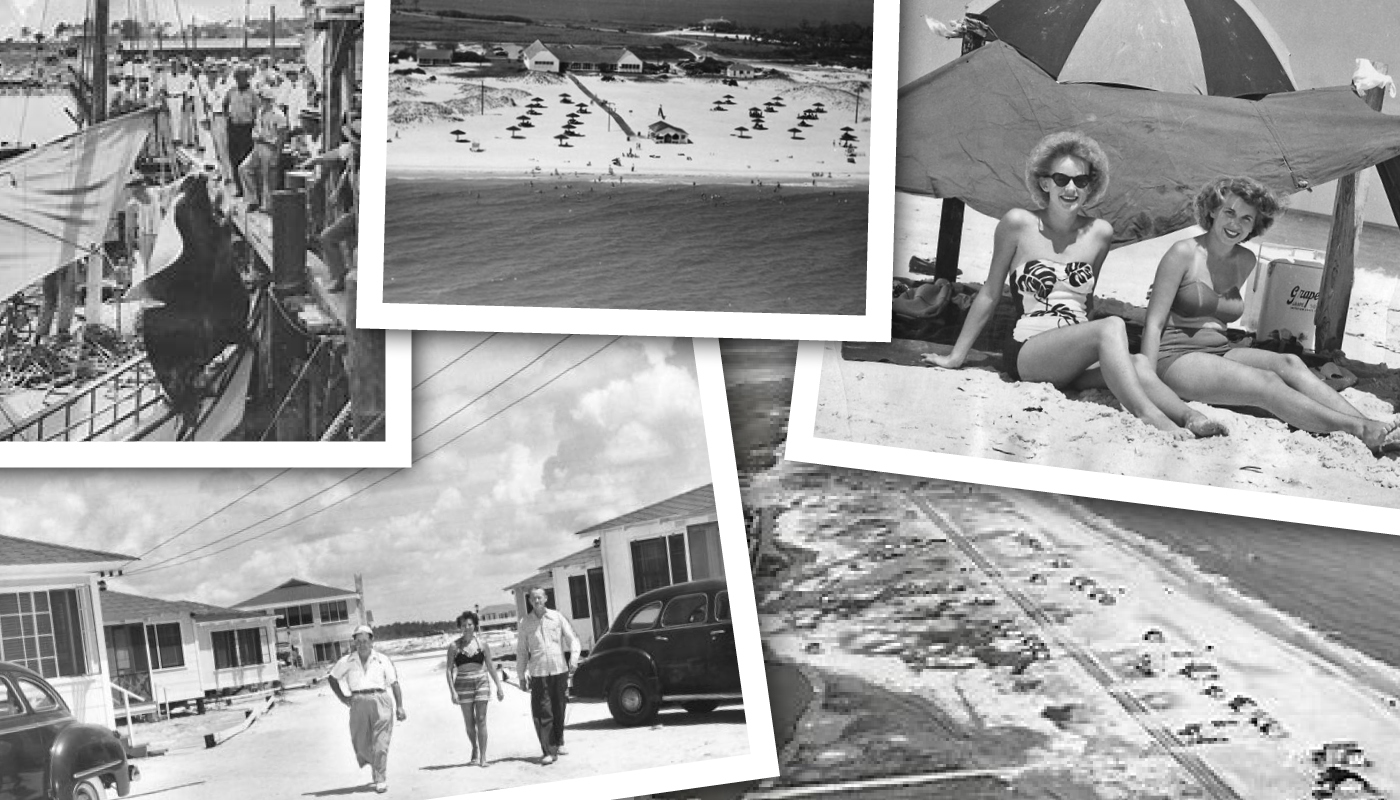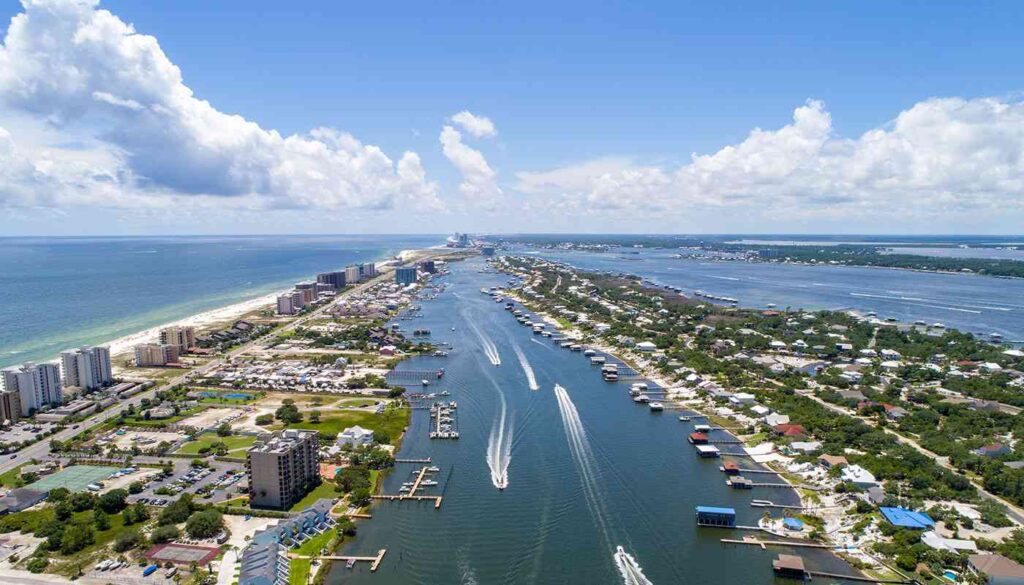
Then to Now – The History of Gulf Shores and Orange Beach
June 24, 2022
The story of Gulf Shores and Orange Beach is one of adversity and triumph, redemption and gumption, pirates and pioneers, undaunted human spirits, and sprawling natural beauty. In other words, the story of Gulf Shores and Orange Beach is fascinating.
From sleepy seaside fishing hamlets to bustling beach communities, the evolution of Orange Beach and Gulf Shores has been refreshingly balanced over the years. Both communities still possess the simple, salty charm of yesteryear but also boast tasteful modernity and amenities. (A delightful mix if you ask us!)
Here’s a brief history of Orange Beach and Gulf Shores—the tale of a tiny fishing village that became a thriving destination, a story of back bays and coves, salt captains and spartan settlers, water and land, and the peoples that not only inhabit these waters and lands but embody their free-flowing adaptable spirits.
The Early Days
Since time immemorial, the area of Gulf Shores and Orange Beach has played host to human civilizations. For millennia, Native Americans occupied this area. Early tribes such as Creeks, Alabamas, Cherokees, Choctaws, Chickasaws, and Seminals lived off the rich bounty of land and sea. Today, it’s not uncommon to discover old Native American pottery or artifacts hidden in the pine forest soils and backwater bay sands.
Eventually, European explorers and Spanish conquistadors touched down on the sugar-white coast of Gulf Shores and Orange Beach. With them, they brought ships, seafaring modes of living, forts, and even a fair share of pirates who prowled the Gulf of Mexico.
In the early 1800s, the first modern-day settlers began staking claims. Attracted by the vast interconnected waterways and abundant pine forests, they lived off the land and sea, establishing distinct communities along the way. By the 1860s, Orange Beach was its own distinct community.
From Logging to Fishing
In the early days, the area’s vast pine forests made Gulf Shores and Orange Beach prime real estate for a booming lumber industry. From turpentine harvesting to shingle-making, the original growth of the area arrived on the bountiful back of trees.
Eventually, another innovation would prove to drastically alter the ethos and growth potential of the area: the boat. Boats have played a vast and hugely prominent role in the history of Gulf Shores and Alabama. There were more boats than automobiles for a large chunk of the 20th Century. Used for transportation, for taking cargo to and from town, and of course for fishing, boats provided the lifeblood livelihood for many Orange Beach and Gulf Shores families.
It’s no surprise that Gulf Shores and Orange Beach became prominent fishing villages. Shrimping, oystering, and fishing employed almost everyone in the area throughout the early settlement years until the 1970s. However, fishing wasn’t just a primary industry; it was a way of life.
The 20th Century
In the early days of the 20th Century, life in Gulf Shores and Orange Beach was still relatively spartan. There was no electricity. Residents ate what they harvested. They grew sugar cane for rum and molasses and raised cows, goats, and pigs for meat. Highway 59 was a red clay road. Life was good but hard, hard but good.
In 1905, the railroad arrived. With it came various other signs of progress: groceries, hardware stores, and a post office. Gulf Shores and Orange Beach grew.
The completion of the Intracoastal Waterway in 1937—a shipping canal that runs along the Gulf and East Coast—compounded that growth. It reshaped the area and made it more accessible.
The Arrival of Tourism
While locals were living and thriving in the backwater bays, tourists soon got wind of the beaches—the beautiful, pristine, otherworldly beaches. Soon, the sleepy fishing villages of Orange Beach and Gulf Shores would grow beyond anyone’s wildest imaginations into bustling beach communities.
In the years following World War II, the towns flourished. Cottages and houses proliferated. It became an idyllic beachside town where water sports thrived, and “the eternal summer” found a home. Locals oriented their lives around the water. From sunup to sundown, they would fish, swim, waterski, and do anything and everything on the water.
Soon, visitors joined them. From nearby cities of Mobile and Montgomery, and beyond from other regional hubs, they initially flooded in for the fishing. Early tourists hired local fishermen to take them on guided fishing trips.
These tourists have since stayed for the beaches…. Well, and the fishing—Orange Beach and Gulf Shores still today boast one of the largest charter fishing fleets in the country.
The History of Accommodations
The first tourist-specific lodging to grace the area was the Orange Beach Hotel. Opened in 1923 and overlooking Wolf Bay, this beautiful haven has welcomed visitors for several decades. Today, the building houses the Coastal Art Center.
Other accommodations soon followed: Gulf View Park in the 1930s, and Gulf Gate Lodge in the 1950s. In 1960, White Caps—Orange Beach’s first Gulf front hotel—opened with the area’s first swimming pool. The arrival of condos contributed to an enormous increase in tourism, which still shapes the overall ethos of the area today.
Today, Kaiser Vacation Rentals offers some of the finest continually-curated properties in the area.
Life Is Better Here
In many ways, Gulf Shores and Orange Beach haven’t changed all that much. Over the course of their centuries-long histories, they’ve maintained so much of their original character. Blessed by geography, shaped by wind and sea, molded by an appreciation and dedication to the land, Gulf Shores and Orange Beach are communities where the community comes first—and beaches, backwaters, and fishing come in a very close joint second.
In short, life is better here. It always has been.
BOOK YOUR STAY WITH KAISER VACATION RENTALS TODAY!
Vacation Email Sign Up
Categories
- Community Blog (15)
- Uncategorized (1)
- Vacation Blog (81)
Archives
- July 2024 (1)
- June 2024 (1)
- May 2024 (4)
- April 2024 (1)
- March 2024 (3)
- January 2024 (3)
- December 2023 (4)
- November 2023 (1)
- October 2023 (2)
- September 2023 (1)
- August 2023 (3)
- July 2023 (2)
- June 2023 (1)
- May 2023 (4)
- April 2023 (2)
- March 2023 (2)
- February 2023 (1)
- January 2023 (1)
- December 2022 (5)
- November 2022 (2)
- October 2022 (4)
- September 2022 (3)
- August 2022 (3)
- July 2022 (2)
- June 2022 (4)
- May 2022 (5)
- April 2022 (1)
- March 2022 (7)
- January 2022 (5)
- December 2021 (3)
- November 2021 (3)
- October 2021 (1)
- September 2021 (2)
- August 2021 (2)
- July 2021 (1)
- June 2021 (1)
- May 2021 (1)
- April 2021 (1)
Related Topics
electric vehicle charging stations fort morgan Gulf Shores Orange Beach Property Management United Way



